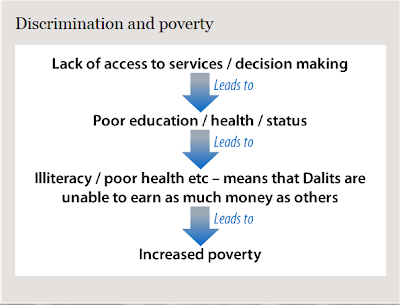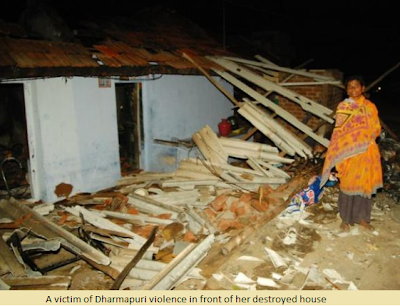Education and development-
Moreover, education brings about development and
urbanization which helps the Dalits to cease depending on upper caste landlords
for livelihood. Many move to urban areas where they find a far better scenario
than the rural localities both in terms of social and economic aspects. The
caste origins are less obvious and less important in urban areas. The influence
of education and development can be understood when one comes to know the human
development indexes of Kerala and Bihar with literacy rates of 93.91% and
63.82% respectively. The 2011 census shows Kerala's HDI is 0.920, which is
higher than that of most developed countries while that of Bihar is 0.467 which
stands at par with the African nation such as Uganda and Senegal.
Government policies
One of the main policies of the government to boost the
upliftment of dalits is the reservation system. Although reservation had helped
a lot in improving the living standards of dalits, the system should be revived
to make it more effective. Currently, the benefits are enjoyed only by the members
of the lower caste who had already attained an elite position in the society
while the rightly eligible people are unable to exploit the opportunities,
primarily due to ignorance. Moreover, the basis of classification of castes as
forward and backward had always been criticized, as the caste hierarchy
differed from one region to another. This was another reason for the partial
failure of reservation system as the classification did not ensure that the
benefits are enjoyed by the right people and right community. Thus the best
solution is to consider class as a basis for granting reservation rather than
caste. Upliftment of more Dalits can be achieved only by ensuring that it is
the poor who is benifited from reservation system.
More strict laws should be formulated to counter caste
discrimination in India. The strict enforcement of such law will result in considerable
decrease in violence against Dalits.
Encouragement of inter caste marriages will also help in
eradicating caste discrimination slowly from the society. Also, more land
reforms should be implemented so as to allot land to the landless Dalits. The
peasants should be given more economic supports such as subsidies and loans
with low interest rate. Free higher education for the backward castes will also
help in their upliftment. Expansion of employment opportunities will also help
in this direction.
Mass communication
All the organs of mass communication should be pressed to
service to eradicate caste discrimination. In this era, when people seem to be
glued to televisions and cinemas, these media should be aptly exploited in fighting
against the social evil. Television serials and cinemas depicting the toils of
the backward caste members and stressing on equality of men could be made.
Channels can broadcast interviews with eminent scholars and social reformers.
The channels and newspapers can bring into light more atrocities against Dalits
and ensure that the guilty are amply punished. More books and articles should
be written against discrimination and all these will ensure that the caste
system is slowly annihilated, as these mass media have a huge cultural impact
on the society.
Political empowerment
It’s always the powerless who are exploited in the society.
When a community does not have political power, their interests are seldom
served. The Dalits had always been subjugated and ruled which hampered their
development. But recently, the reservation of some constituencies had ensured
that they are also adequately represented. But, a Dalit candidate being
blackmailed to back off from elections and murder of elected candidates are daily
news during election period. This should be however countered and dealt with
iron hands and the scheduled castes must be more and more encouraged to
participate in local, state and national level politics. Gladly, improvement in
scenario had been noticed, as in the case of Utter Pradesh. The leader of
Bahujan Samajwadi Party, Mayawati (who is a Dalit), was successful in capturing
power in UP and became the first Dalit chief minister of UP. Since then she
brought in lots of development policies for the Dalits which resulted in the
improvement of living conditions of the Dalits. Even more significantly, she shocked
the world when she succeeded in uniting Brahmins, the uppermost caste and the
Dalits under a single umbrella of her political party. For the scholars, social
reformers and every Indian citizen who stand against caste discrimination, it
was heartening to see Brahmins and Dalits campaigning and working together for
their party. Thus, to sum up, the Dalits should be taught about their political
rights and more participation from them must be ensured by reservation and
dissemination of information about their rights and opportunities.
Improvement of judiciary and police
The judiciary and police force of India were unsuccessful in
preventing caste discrimination.
Human Rights Watch reported that in 1995, 90 to 95
percent of all cases of discrimination against scheduled castes resulted in
non-punishment. In 1992, Indian Supreme Court Justice Ramaswamy declared that more
than 75 percent of the cases brought to court over the Prevention of Atrocities
Act ended in acquittal. These statistics calls for an immediate revival of the
judiciary. Measures should be taken to ensure that judges are not conservative
or biased. Reservation in judiciary for lower castes will help a lot in this
direction. The judges should be enlightened about the previous caste based
cases so that they can efficiently deal with caste based issues.
The police force, ineffective particularly at local levels,
had been a prime reason for the survival of caste system. Most of the
complaints received from lower castes are ignored and sufficient actions are
never taken. Cases in which police themselves commit the atrocities against
scheduled castes are also not uncommon. Therefore, measures should be taken to
make the department corruption free and unbiased so that enforcement of the
laws against discrimination is ensured.
NGOs
The NGOs has a big role to play in eradicating caste
discrimination. They must put more pressure on the government for programmes
such as land reforms, primary education, the fight for equal opportunities and
uniform legislation, and the removal of manual scavenging. Furthermore, they
should try to bring the problems and violence against Dalits into light which
the media fail to address. They can also raise funds, provide employment and
promote the importance of education among the Dalits.
References :
Item Citation
Caste and Economic
Discrimination: Causes, Consequences and Remedies
Sukhadeo Thorat and Katherine S.
Newman
Economic and Political Weekly ,
Vol. 42, No. 41 (Oct. 13 - 19, 2007), pp. 4121-4124
Published by: Economic and
Political Weekly
Article Stable URL: http://www.jstor.org/stable/40276545
Item Citation
Caste Discrimination in the
Indian Urban Labour Market: Evidence from the National Sample Survey
S. Madheswaran and Paul Attewell
Economic and Political Weekly,
Vol. 42, No. 41 (Oct. 13 - 19, 2007), pp. 4146-4153
Published by: Economic and
Political Weekly
Article Stable URL:
http://www.jstor.org/stable/40276549


